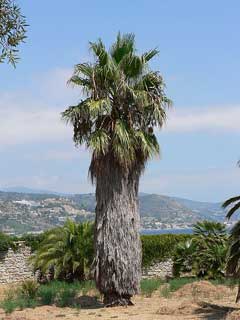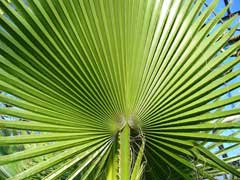 |
|
commons.wikimedia.org/wiki/User:Fale |
 |
| commons.wikimedia.org/wiki/User:Atirador |
Translate this page:
Summary
Bloom Color: White, Yellow. Main Bloom Time: Early spring, Late spring, Mid spring. Form: Palm, Upright or erect.
Physical Characteristics

 Washingtonia is an evergreen Tree growing to 12 m (39ft) by 12 m (39ft) at a medium rate.
Washingtonia is an evergreen Tree growing to 12 m (39ft) by 12 m (39ft) at a medium rate.
See above for USDA hardiness. It is hardy to UK zone 9. It is in leaf all year, in flower from July to August, and the seeds ripen from November to January. The species is hermaphrodite (has both male and female organs).
Suitable for: light (sandy), medium (loamy) and heavy (clay) soils. Suitable pH: mildly acid, neutral and basic (mildly alkaline) soils and can grow in very alkaline and saline soils.
It cannot grow in the shade. It prefers dry or moist soil and can tolerate drought.
UK Hardiness Map
US Hardiness Map
Synonyms
Brahea filamentosa. Brahea filifera. Livistona filamentosa. Neowashingtonia filamentosa. Neowashingt
Plant Habitats
Edible Uses
Fruit - raw or cooked or dried for later use[2, 46, 161, 177, 257]. It can be made into jellies and drinks or dried and ground into a meal[46, 183]. The seed can be ground up with the dried fruit and then both are eaten as a porridge[246]. The fruit is small and hard[213], but has a thin sweet pulp that tastes somewhat like dates[183, 213]. The ovoid fruit is about 6mm long and 4mm wide[200]. Young central bud - roasted[46, 177, 183]. Harvesting this central bud will kill the tree since it is unable to make side branches[K]. Young leaf bases - raw or cooked[161, 177]. Seed - cooked. It can be ground into a powder and used for making bread or porridge[161, 183].
References More on Edible Uses
Medicinal Uses
Plants For A Future can not take any responsibility for any adverse effects from the use of plants. Always seek advice from a professional before using a plant medicinally.
None known
References More on Medicinal Uses
The Bookshop: Edible Plant Books
Our Latest books on Perennial Plants For Food Forests and Permaculture Gardens in paperback or digital formats.

Edible Tropical Plants
Food Forest Plants for Hotter Conditions: 250+ Plants For Tropical Food Forests & Permaculture Gardens.
More

Edible Temperate Plants
Plants for Your Food Forest: 500 Plants for Temperate Food Forests & Permaculture Gardens.
More

More Books
PFAF have eight books available in paperback and digital formats. Browse the shop for more information.
Shop Now
Other Uses
A fibre from the leaves is used in basket making and for cordage[46, 169]. The whole leaves are woven and used as the side walls and roofs of huts and temporary dwellings[46, 257]. The seeds have been used as the rattle in gourd rattles[257]. Wood - light and soft[82]. It has been used for making cooking implements, spoons etc[257].
Special Uses
References More on Other Uses
Cultivation details
Landscape Uses:Container, Pest tolerant, Specimen, Street tree. Requires a sheltered sunny position in a fertile moist but well-drained soil[188, 231]. Tolerates some salt in the soil[200] and maritime exposure in climates that are warmer than Britain[200]. Plants can tolerate extensive droughts so long as their roots have tapped into underground water supplies[231]. Plants can tolerate light frosts and should succeed outdoors in the mildest parts of Britain[166]. They have been known to tolerate short-lived lows down to about -10°c[231]. This species has an extensive and fleshy but strong root system that can penetrate to a considerable depth in search of water[231]. It generally establishes best when planted out at a young stage. However, older plants are substantially more cold tolerant than juvenile plants[231]. In areas at the limit of their cold tolerance, therefore, it is prudent to grow the plants in containers for some years, giving them winter protection, and only planting them into their permanent positions when sheer size dictates[231]. Palms can also be transplanted even when very large. Although the thick fleshy roots are easily damaged and/or desiccated, new roots are generally freely produced. It is important to stake the plant very firmly to prevent rock, and also to give it plenty of water until re-established - removing many of the leaves can also help[231]. Plants growing in the wild are seen as an indication of underground water[200]. Plants produce a 'skirt' of old dead leaves, this can be a fire hazard and the old leaves are usually removed when being grown in areas liable to forest fires[200]. A fast growing tree, even when young, in its native environment and very tolerant of transplanting despite its deep root system[200]. Special Features:Attracts birds, North American native, Naturalizing, Inconspicuous flowers or blooms.
References Carbon Farming Information and Carbon Sequestration Information
Temperature Converter
Type a value in the Celsius field to convert the value to Fahrenheit:
Fahrenheit:
The PFAF Bookshop
Plants For A Future have a number of books available in paperback and digital form. Book titles include Edible Plants, Edible Perennials, Edible Trees,Edible Shrubs, Woodland Gardening, and Temperate Food Forest Plants. Our new book is Food Forest Plants For Hotter Conditions (Tropical and Sub-Tropical).
Shop Now
Plant Propagation
Seed - best sown as soon as it is ripe in a greenhouse. Pre-soaking for 24 hours in warm water may speed up germination, especially of stored seed[200]. When they are large enough to handle, prick the seedlings out into individual pots and grow them on in the greenhouse for at least their first two winters. Plant them out into their permanent positions in late spring or early summer, after the last expected frosts. Give the plants some protection from the cold for at least their first two winters outdoors.
Other Names
If available other names are mentioned here
Native Plant Search
Search over 900 plants ideal for food forests and permaculture gardens. Filter to search native plants to your area. The plants selected are the plants in our book 'Plants For Your Food Forest: 500 Plants for Temperate Food Forests and Permaculture Gardens, as well as plants chosen for our forthcoming related books for Tropical/Hot Wet Climates and Mediterranean/Hot Dry Climates. Native Plant Search
Found In
Countries where the plant has been found are listed here if the information is available
Weed Potential
Right plant wrong place. We are currently updating this section.
Please note that a plant may be invasive in one area but may not in your area so it’s worth checking.
Conservation Status
IUCN Red List of Threatened Plants Status :

Growth: S = slow M = medium F = fast. Soil: L = light (sandy) M = medium H = heavy (clay). pH: A = acid N = neutral B = basic (alkaline). Shade: F = full shade S = semi-shade N = no shade. Moisture: D = dry M = Moist We = wet Wa = water.

Expert comment
Author
(Linden. ex André.)H.Wendl.
Botanical References
71
Links / References
For a list of references used on this page please go here
Readers comment
| Add a comment |
|
If you have important information about this plant that may help other users please add a comment or link below. Only comments or links that are felt to be directly relevant to a plant will be included. If you think a comment/link or information contained on this page is inaccurate or misleading we would welcome your feedback at [email protected]. If you have questions about a plant please use the Forum on this website as we do not have the resources to answer questions ourselves.
* Please note: the comments by website users are not necessarily those held by PFAF and may give misleading or inaccurate information.
To leave a comment please Register or login here All comments need to be approved so will not appear immediately.
|
|